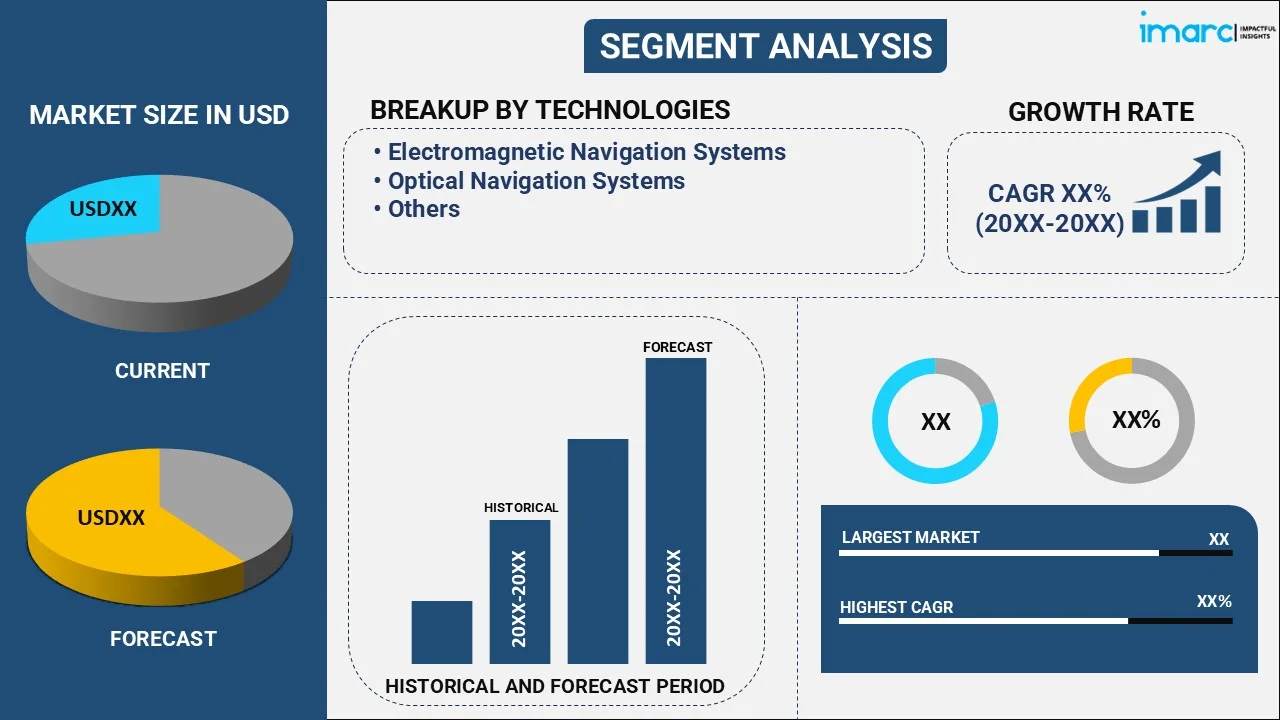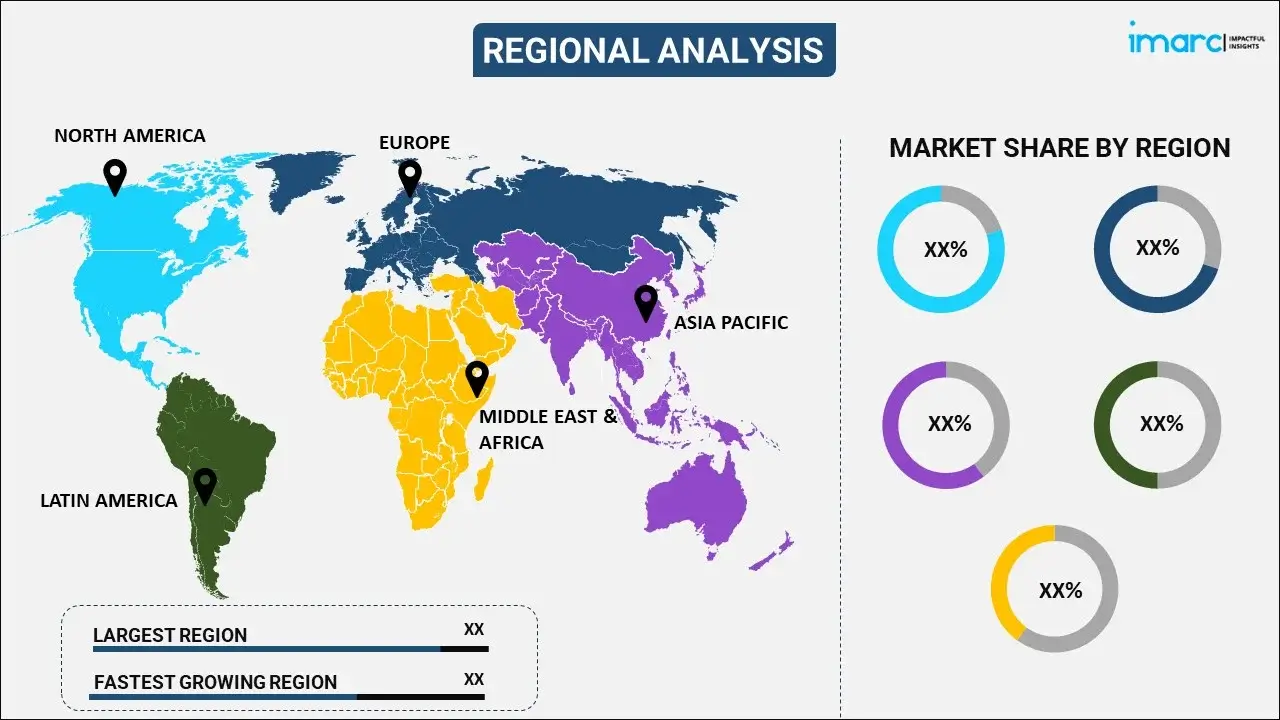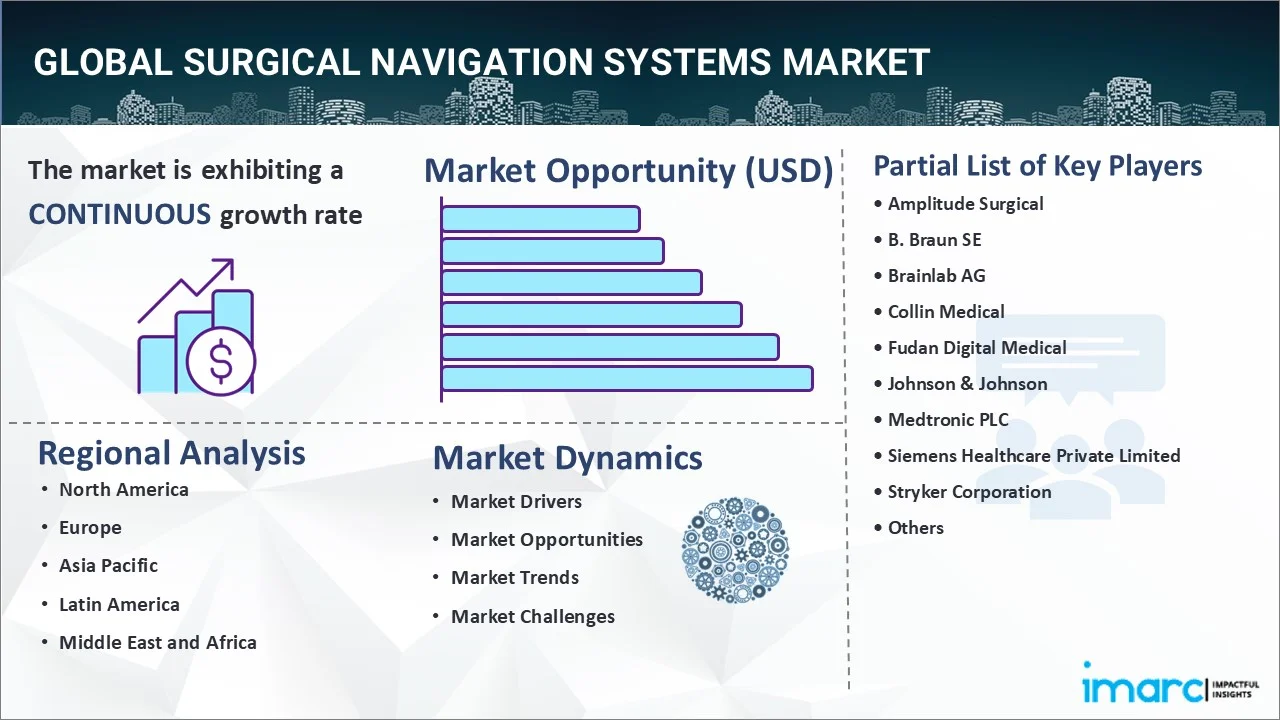
Surgical Navigation Systems Market Report by Technology (Electromagnetic Navigation Systems, Optical Navigation Systems, and Others), Application (Neurosurgery, Orthopedic, ENT, Dental, and Others), End User (Hospitals, Ambulatory Surgical Centers), and Region 2025-2033
Global Surgical Navigation Systems Market:
The global surgical navigation systems market size reached USD 9.7 Billion in 2024. Looking forward, IMARC Group expects the market to reach USD 22.5 Billion by 2033, exhibiting a growth rate (CAGR) of 9.76% during 2025-2033. The rising burden of chronic diseases, the aging population, the growing need for minimally invasive (MI) procedures, and the integration of novel visualization technologies into surgical navigation systems represent some of the key factors driving the market growth.
|
Report Attribute
|
Key Statistics
|
|---|---|
|
Base Year
|
2024
|
|
Forecast Years
|
2025-2033
|
|
Historical Years
|
2019-2024
|
|
Market Size in 2024
|
USD 9.7 Billion |
|
Market Forecast in 2033
|
USD 22.5 Billion |
| Market Growth Rate 2025-2033 | 9.76% |
Surgical Navigation Systems Market Analysis:
- Major Market Drivers: The surging burden of chronic diseases, including cancer, orthopedic disorders, neurological conditions, etc., is primarily driving the market growth. Moreover, ongoing advancements in surgical navigation technology, such as improved imaging modalities, enhanced software algorithms, and augmented reality integration, are also propelling the market growth.
- Key Market Trends: Integration of artificial intelligence (AI) and machine learning, growing inclination towards the development of portable and handheld navigation systems, rising advancement in imaging modalities, etc., are expected to proliferate the market demand. Furthermore, the surgical navigation system market is also expanding due to increasing healthcare infrastructure investments, rising demand for advanced medical technologies, and growing awareness among healthcare professionals.
- Competitive Landscape: Some of the leading surgical navigation systems market companies are Amplitude Surgical, B. Braun SE, Brainlab AG, Collin Medical, Fudan Digital Medical, Johnson & Johnson, Medtronic PLC, Siemens Healthcare Private Limited, Stryker Corporation, and Zimmer Biomet Holdings Inc., among many others.
- Geographical Trends: According to the report, North America accounted for the largest market share. North America acquired the most prominent share owing to various factors, such as the aging population, rising incidences of chronic diseases, escalating demand for surgical procedures, ongoing technological innovations, etc. North America is at the forefront of technological innovation in healthcare, and this applies to surgical navigation systems as well. Continuous advancements in navigation technology, such as improved imaging modalities, enhanced software algorithms, and integration with other surgical tools, drive the surgical navigation systems market demand.
- Challenges and Opportunities: High initial cost of surgical navigation systems, complexity of integration, need for specialized training, and regulatory compliance are some of the key challenges that the market is facing. However, the integration of surgical navigation systems with robotic surgical platforms and digital surgery technologies presents numerous surgical navigation systems market opportunities for enhanced procedural accuracy, automation, and surgical efficiency. Collaborations between navigation system manufacturers and robotics companies can lead to innovative solutions for minimally invasive surgery, thereby supporting the industry’s demand.
Surgical Navigation Systems Market Trends:
Surging Cases of Musculoskeletal and Neurological Disorders
As the global population ages, there's a natural increase in age-related conditions, such as osteoarthritis, degenerative disc disease, and neurological disorders like Alzheimer's and Parkinson's disease. The aging demographic contributes significantly to the rise in musculoskeletal and neurological disorders. For instance, according to the report published by the World Health Organization in July 2022, nearly 1.71 billion people suffer from musculoskeletal disease owing to the aging population. Apart from this, continuous advancements in surgical navigation technology, including improved imaging modalities, augmented reality integration, and AI-driven navigation algorithms, enhance the capabilities of these systems in addressing complex musculoskeletal and neurological cases. Surgeons are more inclined to adopt navigation systems with advanced features to improve patient outcomes. For instance, in December 2023, Quibim, a company leading imaging biomarkers for precision medicine launched QP-Brain. QP-Brain is a technology that uses artificial intelligence (AI) to automatically quantify, and present results based on the data from MRI Scans directly in PACS, making it easier to perform quantitative analysis on patients' brains for neurological disorders. Besides this, governments of various countries are taking initiatives in order to create awareness regarding musculoskeletal disorders in the workplace. For instance, in January 2024, the National Safety Council (NSC), in partnership with Amazon, launched the MSD Solutions Index Pledge Community Report, which highlights progress in reducing musculoskeletal disorders (MSDs) in the workplace. The analysis, based on a survey of over 50 prominent firms, identifies both encouraging developments and places for improvement in preventing the most prevalent workplace accident, which costs employers approximately US$ 17 Billion per year. These factors are bolstering the surgical navigation systems market revenue.
Rising Penetration of Robotic Navigation
Robot navigation systems offer high levels of precision and accuracy in guiding surgical instruments during procedures. By leveraging advanced imaging technologies and real-time feedback, these systems enable surgeons to navigate complex anatomical structures with greater confidence and precision, reducing the risk of errors and improving surgical outcomes. For instance, in December 2022, BLK-Max Super Specialty Hospital launched an integrated robotic system for spine surgeries in order to increase the safety and accuracy of the surgery. Moreover, robot navigation systems provide surgeons with enhanced visualization capabilities, including 3D imaging and augmented reality overlays. This improved visualization allows for better spatial orientation and depth perception, facilitating more precise navigation and tissue manipulation during surgery. For instance, in September 2022, eCential Robotics, a French growth MedTech company that designs and manufactures a system that combines 2D/3D imaging, surgical navigation, and robotics, announced FDA 510(k) clearance for its 3D imaging, navigation, and robotics guidance system, securing the penetration of its unified robotic platform in the United States. In line with this, Zeta Surgical, a surgical robotics and mixed reality business, successfully treated its first patient with the Zeta Cranial Navigation System during its first-in-human study at Singapore's National Neuroscience Institute (NNI). These factors are further contributing to the surgical navigation systems market share.
Increasing Adoption of Minimally Invasive Surgical Techniques
Minimally invasive surgical techniques require precise navigation due to limited visibility and access to the surgical site. Navigation systems provide real-time guidance and feedback, enabling surgeons to navigate complex anatomical structures with greater accuracy during MIS procedures. For instance, in August 2023, Orthofix Medical Inc., a global spine and orthopedics company, launched and completed the first cases in the United States using the 7D FLASH Navigation System Percutaneous Module 2.0. The Percutaneous Module 2.0 adds new planning capabilities and capability to Orthofix's 7D FLASH Navigation System, allowing it to better serve the Minimally Invasive Surgery (MIS) spine industry. Moreover, minimally invasive techniques are being increasingly utilized across various surgical specialties, including orthopedics, neurosurgery, cardiovascular surgery, and gynecology. Navigation systems accommodate the diverse needs of these specialties, driving the market growth across multiple clinical areas. For instance, in February 2024, Philips launched LumiGuide, which uses Fiber Optic RealShape (FORS) technology to enable minimally invasive surgery without the use of X-ray radiation for vascular surgery. Furthermore, regulatory agencies, such as the FDA in the United States and the CE mark in Europe, approved navigation systems for use in minimally invasive surgeries. Clear regulatory pathways and approvals provide assurance of safety and efficacy, encouraging the adoption of navigation technology in minimally invasive procedures. For instance, in May 2023, Novarad received approval from Indonesia's Food and Drug Administration (FDA) for VisAR surgical navigation system for minimally invasive surgery. These factors are positively influencing the surgical navigation systems market forecast.
Surgical Navigation Systems Industry Segmentation:
IMARC Group provides an analysis of the key trends in each segment of the global surgical navigation systems market, along with forecasts at the global, regional, and country levels from 2025-2033. Our report has categorized the market based on technology, application, and end user.
Breakup by Technology:

- Electromagnetic Navigation Systems
- Optical Navigation Systems
- Others
Electromagnetic navigation systems dominates the market
The report has provided a detailed breakup and analysis of the surgical navigation systems market based on technology. This includes electromagnetic navigation systems, optical navigation systems, and others. According to the report, electromagnetic navigation systems represented the largest segment.
Electromagnetic navigation systems are valuable tools used in surgical navigation systems across various medical fields. These systems utilize electromagnetic fields to track the position of instruments or devices within the body, providing real-time guidance to surgeons during procedures. Moreover, surgeons can use electromagnetic navigation systems during the pre-operative phase to plan surgical approaches and trajectories. By overlaying imaging data (such as CT scans or MRI) onto a computer-generated model of the patient's anatomy, surgeons can simulate the procedure and determine the optimal path for instrument insertion. For instance, in May 2024, Centerline Biomedical, Inc., was awarded a MedTech Outlook Award as a 2024 top surgical devices company. The company is known for Revolutionizing Interventional Procedures with IOPS Technology. Endovascular surgeries benefit from IOPS's innovative 3D visualization, electromagnetic navigation, and radiation safety features.
Breakup by Application:
- Neurosurgery
- Orthopedic
- ENT
- Dental
- Others
Neurosurgery hold the largest share in the market
A detailed breakup and analysis of the surgical navigation systems market based on the application has also been provided in the report. This includes neurosurgery, orthopedic, ENT, dental, and others. According to the report, neurosurgery accounted for the largest market share.
As per the surgical navigation systems market outlook, surgical navigation systems have revolutionized neurosurgery by providing neurosurgeons with advanced tools for precise planning and execution of complex procedures involving the brain and spine. It assists neurosurgeons in accurately locating and delineating brain tumors, even those deep within the brain. By overlaying pre-operative imaging onto the patient's anatomy in real-time, surgeons can precisely navigate to the tumor, minimizing damage to surrounding healthy brain tissue. For instance, in January 2024, Zeta Surgical, a surgical robotics and mixed reality firm, received FDA special 510(k) clearance for increased features and expanded compatibility with their cranial navigation system for neurosurgery.
Breakup by End User:
- Hospitals
- Ambulatory Surgical Centers
Hospitals accounts for the majority of the market share
The report has provided a detailed breakup and analysis of the surgical navigation systems market based on end users. This includes hospitals and ambulatory surgical centers. According to the surgical navigation systems market report, hospitals represented the largest segment.
Surgical navigation systems are increasingly being used in hospitals for various procedures, especially those involving delicate or intricate surgeries. Surgeons can use surgical navigation systems to plan the surgery before entering the operating room. This involves reviewing medical images such as CT scans, MRI scans, or ultrasound to map out the procedure and identify critical structures. In addition, during surgery, navigation systems provide real-time feedback to the surgeon, helping them navigate through complex anatomical structures with precision. This guidance can be particularly useful in minimally invasive procedures where the surgeon's direct line of sight may be limited. For instance, in January 2024, AdventHealth for Children, a nationally recognized children's hospital and pediatric specialty network situated in Central Florida, successfully completed cranial vault reconstruction for craniosynostosis using the VisAR augmented reality surgical navigation system.
Breakup by Region:

- North America
- United States
- Canada
- Asia-Pacific
- China
- Japan
- India
- South Korea
- Australia
- Indonesia
- Others
- Europe
- Germany
- France
- United Kingdom
- Italy
- Spain
- Russia
- Others
- Latin America
- Brazil
- Mexico
- Others
- Middle East and Africa
North America exhibits a clear dominance in the market
The market research report has also provided a comprehensive analysis of all the major regional markets, which include Europe (Italy, Germany, France, Spain, the United Kingdom, Russia, and others); North America (the United States and Canada); Asia Pacific (China, Japan, Australia, South Korea, Indonesia, India, and others); Latin America (Brazil, Mexico, and others); and the Middle East and Africa. According to the report, North America accounted for the largest market share.
According to the surgical navigation systems market overview, North America is a hub for technological innovation in healthcare. Continuous advancements in surgical navigation technologies, such as the integration of artificial intelligence (AI), augmented reality (AR), and machine learning algorithms, are enhancing the precision, efficiency, and safety of surgical procedures. These innovations drive demand for advanced surgical navigation systems in the region. Moreover, the rising prevalence of chronic diseases, such as cardiovascular diseases, cancer, and orthopedic disorders, is driving the demand for surgical interventions. Surgical navigation systems play a crucial role in performing complex surgeries with greater accuracy and precision, leading to better patient outcomes and reduced post-operative complications. For instance, in May 2023, Novarad, a U.S.-based medical device company, received approval from Indonesia's Food and Drug Administration (FDA) for VisAR surgical navigation system for minimally invasive surgery.
Competitive Landscape:
The report has also provided a comprehensive analysis of the competitive landscape in the global surgical navigation systems market. Detailed profiles of all major companies have been provided. Some of the companies covered include:
- Amplitude Surgical
- B. Braun SE
- Brainlab AG
- Collin Medical
- Fudan Digital Medical
- Johnson & Johnson
- Medtronic PLC
- Siemens Healthcare Private Limited
- Stryker Corporation
- Zimmer Biomet Holdings Inc.
(Please note that this is only a partial list of the key players, and the complete list is provided in the report.)
Surgical Navigation Systems Market Recent Developments:
- May 2024: A surgeon in the state for the first time, Dr. Jonathan Lewin, Director of The Center for Musculoskeletal Disorders (CMD), New Jersey, began using the PathKeeper Surgical Spinal Navigation System.
- May 2024: Centerline Biomedical, Inc., was awarded a MedTech Outlook Award as a 2024 top surgical devices company. The company is known for Revolutionizing Interventional Procedures with IOPS Technology. Endovascular surgeries benefit from IOPS's innovative 3D visualization, electromagnetic navigation, and radiation safety features.
- August 2023: Orthofix Medical Inc., a global spine and orthopedics company, launched and completed the first cases in the United States using the 7D FLASH™ Navigation System Percutaneous Module 2.0.
Surgical Navigation Systems Market Report Scope:
| Report Features | Details |
|---|---|
| Base Year of the Analysis | 2024 |
| Historical Period | 2019-2024 |
| Forecast Period | 2025-2033 |
| Units | Billion USD |
| Scope of the Report | Exploration of Historical and Forecast Trends, Industry Catalysts and Challenges, Segment-Wise Historical and Predictive Market Assessment:
|
| Technologies Covered | Electromagnetic Navigation Systems, Optical Navigation Systems, Others |
| Applications Covered | Neurosurgery, Orthopedic, ENT, Dental, Others |
| End Users Covered | Hospitals, Ambulatory Surgical Centers |
| Regions Covered | Asia Pacific, Europe, North America, Latin America, Middle East and Africa |
| Countries Covered | United States, Canada, Germany, France, United Kingdom, Italy, Spain, Russia, China, Japan, India, South Korea, Australia, Indonesia, Brazil, Mexico |
| Companies Covered | Amplitude Surgical, B. Braun SE, Brainlab AG, Collin Medical, Fudan Digital Medical, Johnson & Johnson, Medtronic PLC, Siemens Healthcare Private Limited, Stryker Corporation, Zimmer Biomet Holdings Inc., etc. |
| Customization Scope | 10% Free Customization |
| Post-Sale Analyst Support | 10-12 Weeks |
| Delivery Format | PDF and Excel through Email (We can also provide the editable version of the report in PPT/Word format on special request) |
Key Questions Answered in This Report:
- How has the global surgical navigation systems market performed so far, and how will it perform in the coming years?
- What are the drivers, restraints, and opportunities in the global surgical navigation systems market?
- What is the impact of each driver, restraint, and opportunity on the global surgical navigation systems market?
- What are the key regional markets?
- Which countries represent the most attractive surgical navigation systems market?
- What is the breakup of the market based on technology?
- Which is the most attractive technology in the surgical navigation systems market?
- What is the breakup of the market based on the application?
- Which is the most attractive application in the surgical navigation systems market?
- What is the breakup of the market based on the end user?
- Which is the most attractive end user in the surgical navigation systems market?
- What is the competitive structure of the global surgical navigation systems market?
- Who are the key players/companies in the global surgical navigation systems market?
Key Benefits for Stakeholders:
- IMARC’s report offers a comprehensive quantitative analysis of various market segments, historical and current market trends, market forecasts, and dynamics of the surgical navigation systems market from 2019-2033.
- The research study provides the latest information on the market drivers, challenges, and opportunities in the global surgical navigation systems market.
- The study maps the leading, as well as the fastest-growing, regional markets. It further enables stakeholders to identify the key country-level markets within each region.
- Porter's five forces analysis assist stakeholders in assessing the impact of new entrants, competitive rivalry, supplier power, buyer power, and the threat of substitution. It helps stakeholders to analyze the level of competition within the surgical navigation systems industry and its attractiveness.
- Competitive landscape allows stakeholders to understand their competitive environment and provides an insight into the current positions of key players in the market.
Need more help?
- Speak to our experienced analysts for insights on the current market scenarios.
- Include additional segments and countries to customize the report as per your requirement.
- Gain an unparalleled competitive advantage in your domain by understanding how to utilize the report and positively impacting your operations and revenue.
- For further assistance, please connect with our analysts.

 Inquire Before Buying
Inquire Before Buying
 Speak to an Analyst
Speak to an Analyst
 Request Brochure
Request Brochure
 Request Customization
Request Customization




.webp)




.webp)












